Chat Interface & Navigation
When opening the Pieces Desktop App after installation, you are first presented with a default view—the Pieces Copilot.
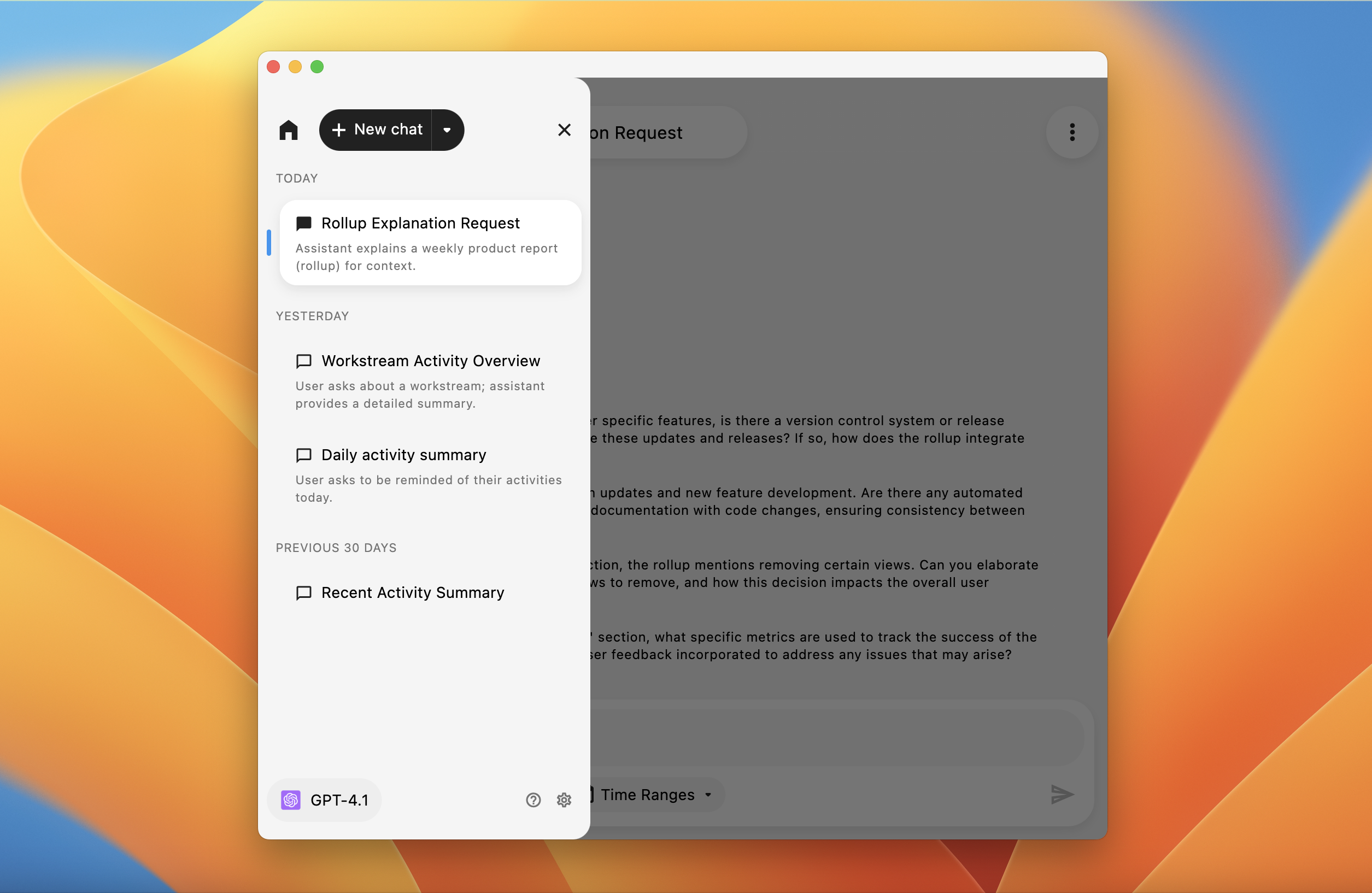
This view is the central hub from which you can start new chats, access previous chats, and configure Long-Term Memory, models, and context to suit the task at hand.
Main Chat Window
The central area of the Pieces Copilot view is a blank chat where you can start a new conversation.
To get the most out of generative AI using local or cloud models through Pieces Copilot, make sure you check out our LLM Prompting Guide.
At the top of the window, you will see a set of three Suggested Prompts—these dynamic prompts adapt based on your topics common to your workflow (if captured by LTM) and serve as a quick way to begin engaging with the AI.
Directly above the chat input field, a Set Context area provides four buttons:
LTM Context: Off / On: Toggle whether to automatically include long-term memory context from your workflow.Folders: Opens a modal to add local code directories.Files: Opens a modal to add individual files.Saved Materials: Lets you pick items previously saved in Pieces Drive.
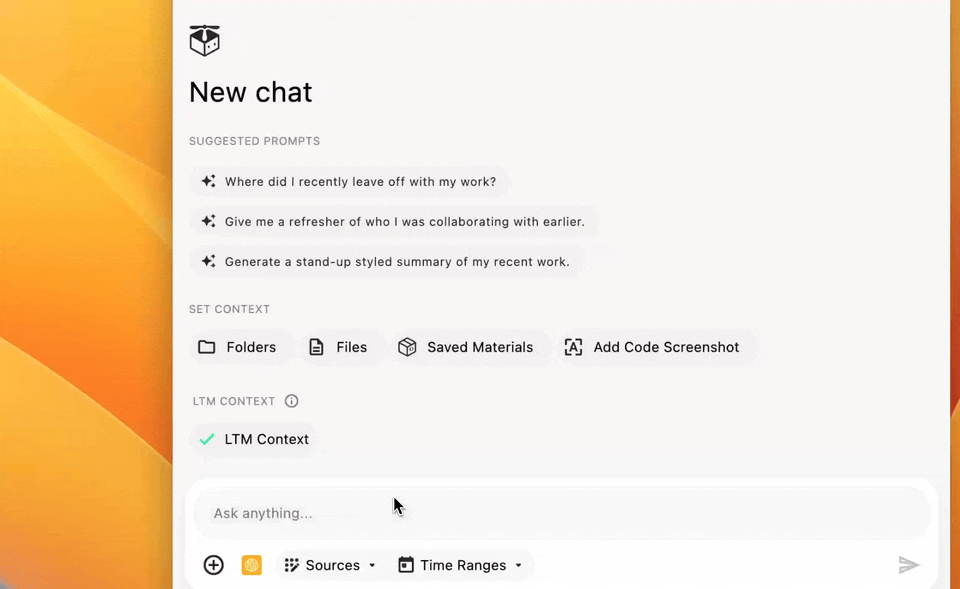
These buttons help you easily inject context into your chat so Pieces Copilot can deliver more accurate and relevant responses.
Input Field and Quick Actions
Inside the Pieces Copilot Chat view, there are several quick actions you can utilize that let you proactively adjust chat context—like toggling the LTM state, adding folders or websites containing code, and more.
Text Input Field
At the bottom of the chat window is a text input field with the placeholder:
“Paste code, drag and drop an image, or ask a technical question…”
This is your primary area for entering queries or pasting code, and is flanked by buttons on either side for adding context or using other in-chat tools:
To the left of the input field is the Quick Action button, which contains a modal menu with quick access to several context-adding actions.
To the right, you’ll find actions to insert code blocks into the chat or extract code from screenshots.

Left-Side Quick-Action Button
Just to the left of the input field is a Chat Bubble icon.
Clicking it opens a context menu with a list of quick actions:
LTM Context: Toggle the current state—on or off.Add Files,Add Folders,Add Snippets,Add Websites: Each option opens the corresponding modal for adding context from local resources or the web.Add Messages:
Read more about adding context to your Pieces Copilot Chats.
Right-Side Tools
Next to the text input field, you’ll find:
A
{ }button that, when clicked, automatically inserts a code block template (using triple backticks) for pasting code.A square button featuring an
“A”icon that enables you to extract code from screenshots. When you click this button, your file explorer opens, allowing you to select an image that contains code.
Chat Options
There are 2 kinds of chat options available within the Pieces Copilot Chat view—actions which let you pin, refresh or delete chats, and the New Chat button with optional Chat Pipelines.
Chat Options Menu
At the top right corner of the active chat window, a vertical ellipsis (three stacked dots) reveals additional options:
Pin Chat: Keeps the current chat pinned at the top of your sidebar.Refresh: Reloads the chat if the AI stops generating a response.Delete: Removes the chat from your history.
Interacting with Generated Responses
When Pieces Copilot generates a reply, a toolbar appears with helpful buttons, icons, and cards to manage or reuse that output.

Response Toolbar Actions
There are several actions you can take under each generated Pieces Copilot response.
Model & Time: A chip shows the model used (for example, Claude, GPT, Gemini, or a local model) and how long ago the response was generated.Copy: Click the copy icon to copy the entire response to your clipboard.Export: Export the response to yourDownloadsfolder by default. You can select from PDF, markdown, or plaintext formats.Regenerate: Use the refresh icon to re-run the response with the same model or a different one. Clicking opens a modal where you can select the model you want to use for the regeneration.Convert to Workstream Summary: The paper icon converts this Copilot output into a Workstream Summary so you can capture and reference it later in your workflow.More Options (⋮): The three-dot menu reveals additional actions. You can selectUse as Contextto add that specific response as context for follow-up prompts, orDelete Messageto remove the message from the current conversation.
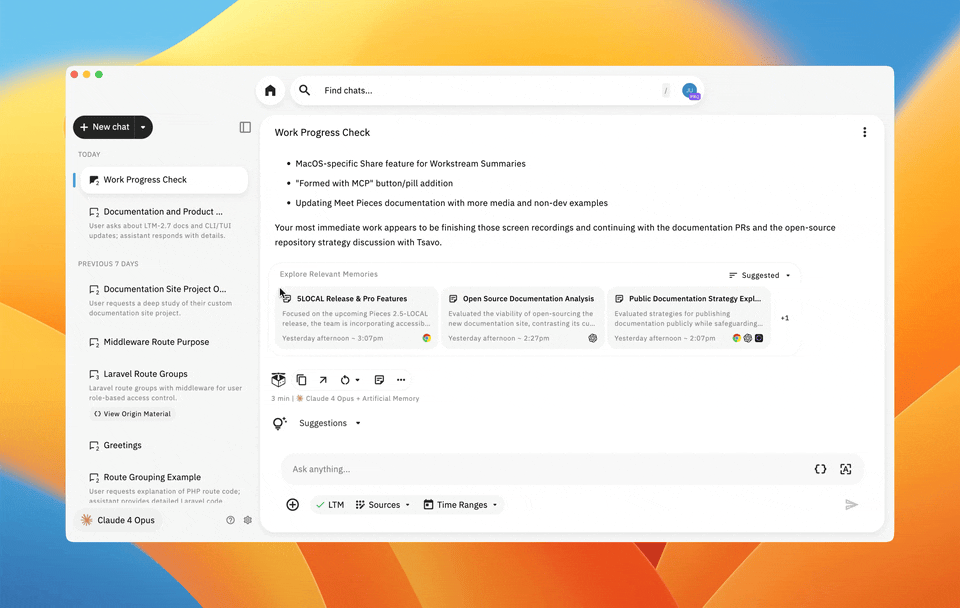
New Chat & Pipelines
In the left sidebar, the New Chat button features a dropdown arrow.
When clicked, it presents you with 3 options:
| Chat Pipeline | Type | Use Case |
|---|---|---|
| Generally discuss technical topics | Multipurpose | For discussing more multi-modal, general but technical topics. |
| Ask questions about a local code base | Project-oriented comprehension and documentation | An optimized LLM pathway for keeping generations relevant to your code context. Useful for learning new codebases. |
| Generate code for a local project | Project-oriented code generation | Oriented for contextualized code generation—works best when local code repositories are added to the chat as context. |
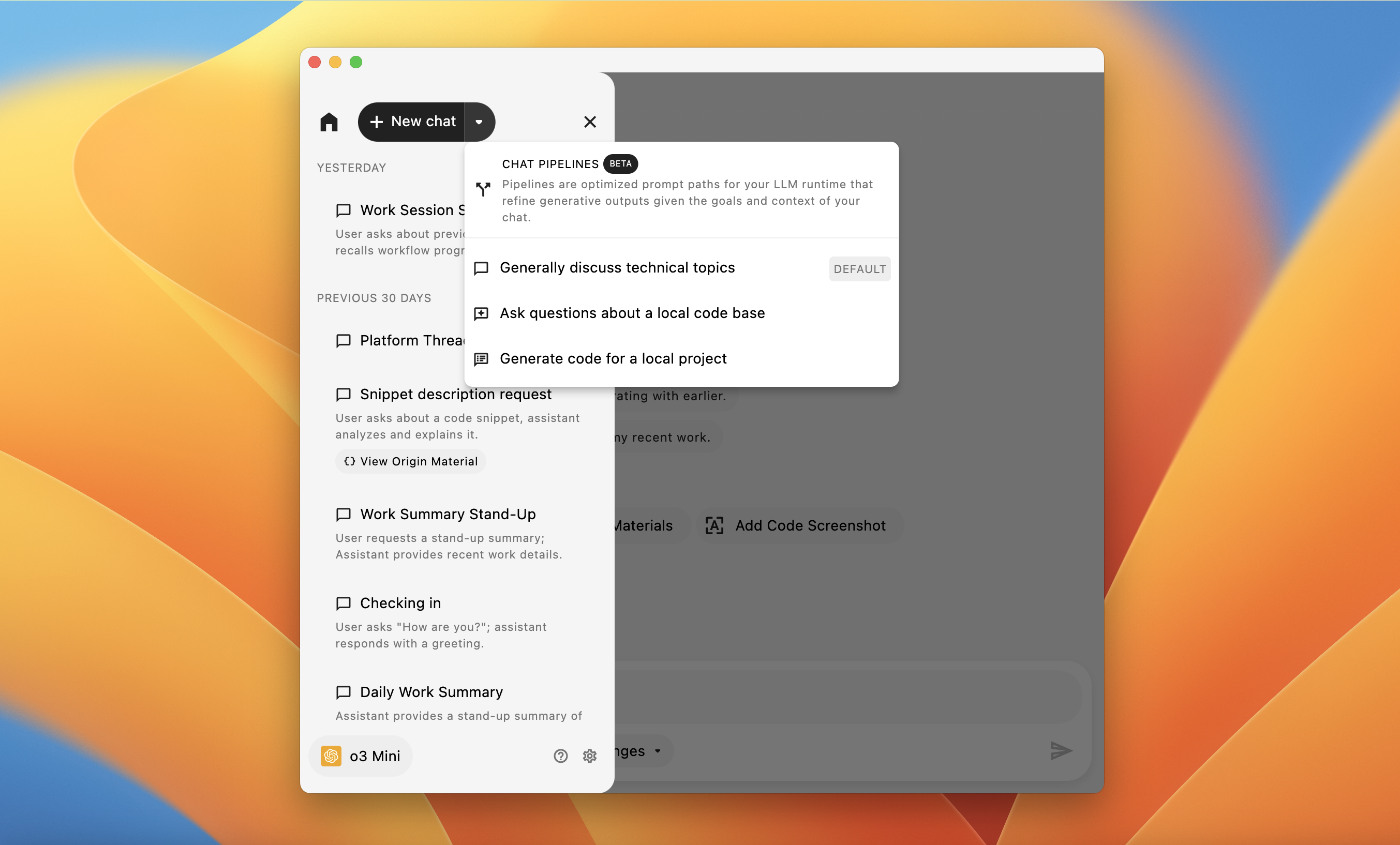
Sidebar & Chat History
When the Pieces Copilot view is opened, you are presented with a left-hand sidebar that displays your past chat conversations arranged chronologically.
This allows you to quickly revisit previous interactions by clicking on a chat entry with its date stamp.
An icon at the top of the sidebar lets you collapse or expand this panel as needed—called Focus Mode—so you can focus solely on your current conversation if desired.
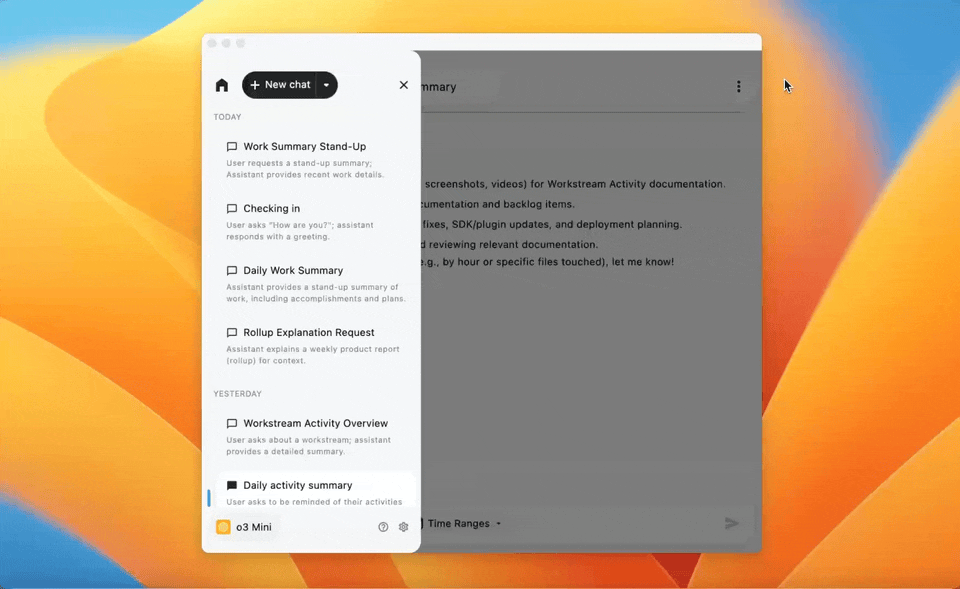
Searching Previous Chats
When you are in the Pieces Copilot view, click the search bar at the very top labeled Find chats….
This opens a centered modal showing your recent chats.
You can scroll this list, and each item displays a percentage on the right that represents how relevant that chat likely is to your current workflow or how frequently you return to it.

Running a Search
Type your query into the search field and press enter (Windows/Linux) or return (macOS) to execute the search. Results will appear with matching terms highlighted in yellow.
If a chat is an exact match for your query, you’ll see an EXACT MATCH label on the right instead of a percentage.
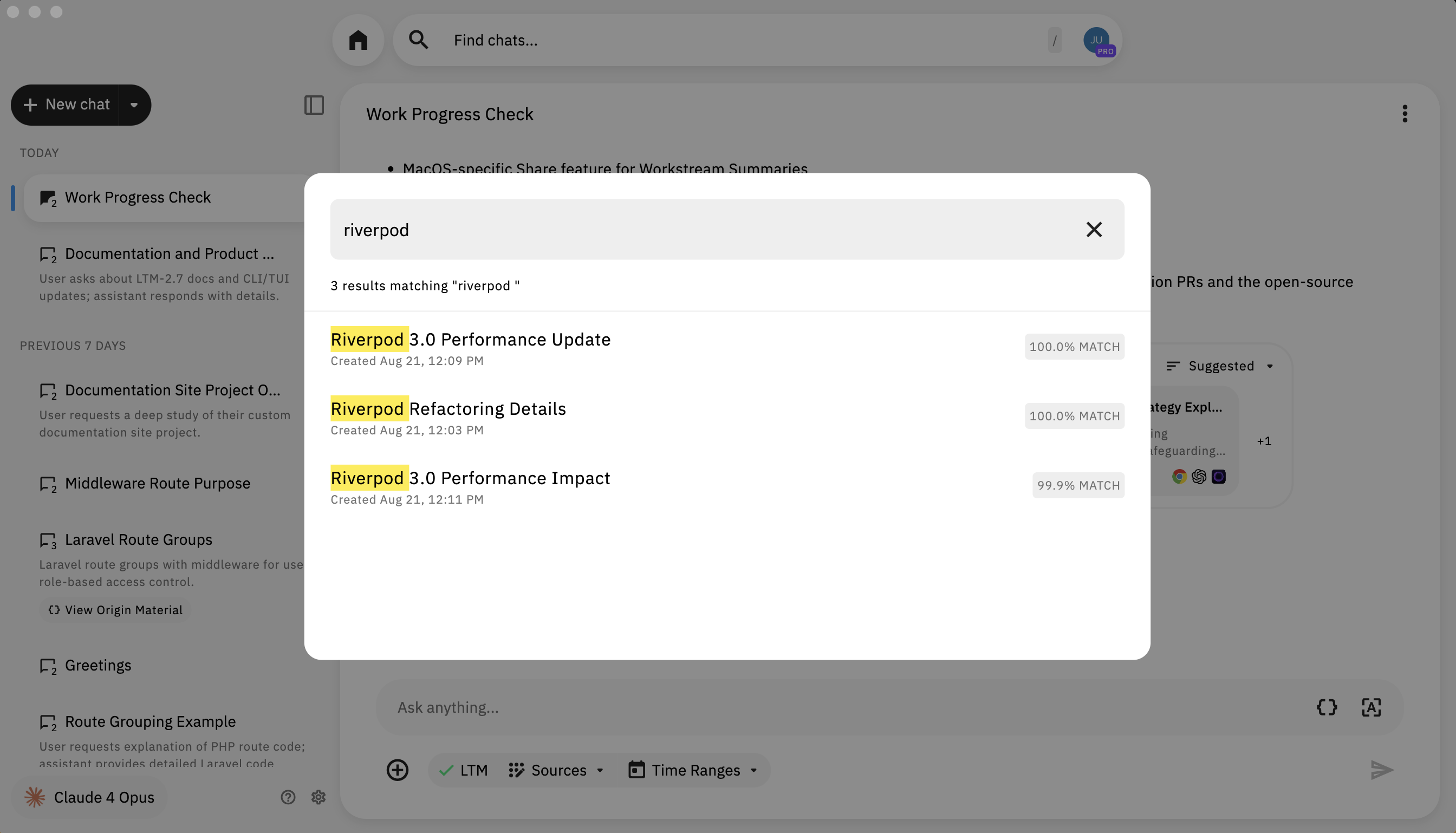
Deep Study
Did you know that Pieces can provide highly accurate, sourced, timestamped deep research reports of your work history, personal projects, and progress on a given topic?
DeepStudy leverages your Long-Term Memory so Copilot can analyze work across people, applications, topics, and time windows.
- Deep contextual recall: Connects information across timeframes, collaborators, and apps
- Comprehensive recaps: Summarizes work done over days, weeks, or months
- Targeted queries: Answers questions that specify people, topics, projects, and date ranges
- Actionable insights: Surfaces linked artifacts (issues, errors, files) and proposes next steps
Using this feature, simply ask Pieces Copilot "Can you perform a deep study on what I've done for the last few days?" and you'll receive an in-depth report that you can save, share, or export on your given topic.
How to Activate Deep Study (Pro)
- At the bottom of any Pieces Copilot chat, click
Activate DeepStudy(labeled with aPRObadge). This toggles the Deep Study workflow for your next prompt. - Deep Study is a Pieces Pro feature.
What to Expect
- Duration: A comprehensive Deep Study typically takes 10–20 minutes to complete, depending on the size of your recent context.
- Progress UI: After you click
Activate DeepStudyand submit a deep-study prompt, you’ll see progress indicators, including aThinkingstate. Multiple agents work in unison; you can expand the chevrons to inspect each agent’s intermediate thoughts and steps as the report is constructed.
Model Used for Deep Study
- Deep Study runs on a dedicated cloud LLM managed by Pieces (currently a Google model, subject to change).
- Changing your selected model via the standard LLM Runtime modal does not affect Deep Study. Your per-chat model choice applies to normal responses, but Deep Study always uses its dedicated runtime.

Example prompts
Use natural language and include time ranges, people, and topics when possible.
Here's some prompts you can try:
Perform a deep study of what I worked on last week related to WebSocket errors.
Tell me everything I did with [PERSON NAME] over the last 3 months.
What did I accomplish related to [TOPIC] in [MONTH]?
When was the last time I worked on [PROJECT/FILE]?